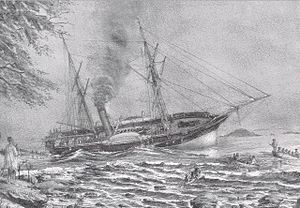 Hydra's sister-ship, Hecate, aground near Cape Flattery in 1861
| |
| History | |
|---|---|
| Name | HMS Hydra |
| Namesake | Hydra |
| Ordered | 18 September 1837 |
| Builder | Chatham Dockyard |
| Cost | £37,239 |
| Laid down | January 1838 |
| Launched | 13 June 1838 |
| Out of service | 13 May 1870 |
| Fate | Sold for breaking up |
| General characteristics [1] | |
| Class and type | Hydra-class sloop |
| Displacement | 1,096 long tons (1,114 t) |
| Tons burthen | 814 91⁄94 bm |
| Length |
|
| Beam | 32 ft 10 in (10.01 m) |
| Draught | 13 ft (4.0 m) |
| Depth of hold | 20 ft 4 in (6.20 m) |
| Installed power | 220 nhp |
| Propulsion |
|
| Sail plan | Brig rig |
| Speed | 9 knots (17 km/h; 10 mph) (under steam) |
| Complement | 135 |
| Armament |
|
| Service record | |
| Commanders: |
|
| Operations: |
|
HMS Hydra was the lead ship of her class of wooden steam paddle sloops of the British Royal Navy, launched in 1838 at Chatham Dockyard. After taking part in operations during the Syrian War in 1840, she then served on anti-slavery operations and also as a survey vessel. She was scrapped in 1870.
- ^ Winfield, R.; Lyon, D. (2004). The Sail and Steam Navy List: All the Ships of the Royal Navy 1815–1889. London: Chatham Publishing. ISBN 978-1-86176-032-6. OCLC 52620555.